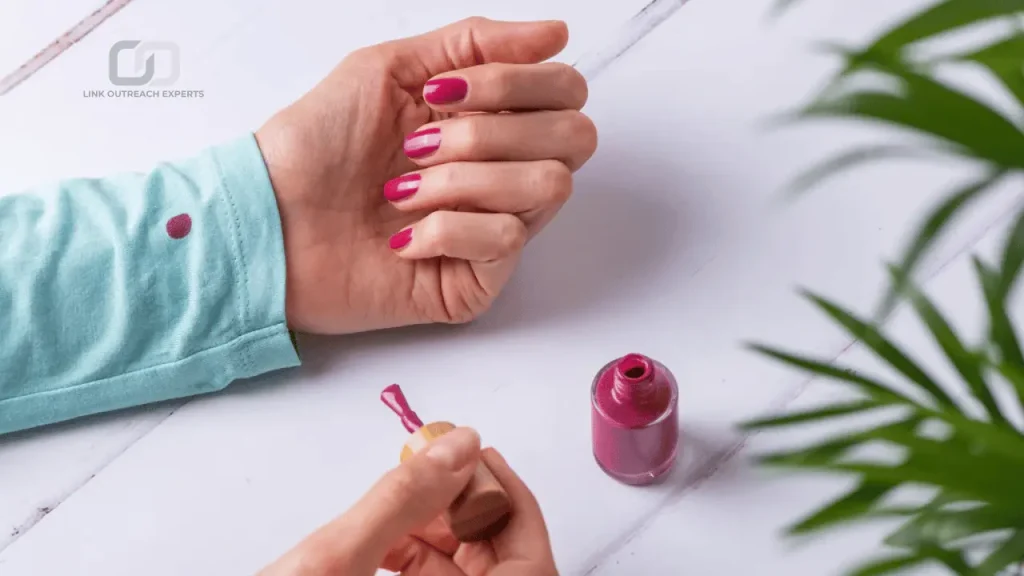Nail polish stains can be hard to remove if left for too long. Wet polish is easier to clean because it has not set into the fabric. If it dries, it can bond with the fibers, making removal more difficult. Acting fast helps prevent deep stains and keeps the fabric from getting damaged. The longer the stain stays, the harder it is to remove completely.
Many people make the mistake of rubbing the stain, which spreads the polish. Instead, blot gently to lift the excess. Another mistake is using hot water, which can set the stain deeper. Some fabrics are sensitive to acetone, so testing it on a hidden area is important. Skipping a pre-wash treatment can leave traces of the stain even after washing.
Table of Contents
Check the Fabric Type
Different fabrics react differently to nail polish removers. Delicate fabrics like silk, wool, and rayon can get damaged if you use acetone or harsh chemicals. Stronger fabrics like cotton, polyester, and denim can handle stronger treatments. Always check the fabric label before choosing a method. Using the wrong cleaner can weaken the fabric or cause discoloration.
If you’re unsure, test a small amount of the cleaner on a hidden part of the fabric. Apply a drop of the remover and wait a few minutes. If the color fades or the fabric changes texture, avoid using that cleaner. Instead, opt for a milder solution like rubbing alcohol or white vinegar. This prevents permanent damage while still removing the stain.
Some fabrics, like suede or leather, need special cleaning techniques. Acetone can dry out these materials, causing cracks or stiffness. For such fabrics, blotting with a damp cloth and mild soap works better. If the stain is stubborn, professional cleaning might be the safest option.
Things You Will Need
- Nail Polish Removers and Alternatives: The most common item is nail polish remover, preferably acetone-free for delicate fabrics. If you don’t have one, rubbing alcohol or hydrogen peroxide can work as alternatives. These solutions help break down the polish without damaging the fabric.
- Blotting and Scraping Tools: Cotton balls, paper towels, or a clean cloth help in blotting the stain. A dull knife or spoon is useful for gently scraping off dried polish without pulling or tearing the fabric. Blotting instead of rubbing prevents the stain from spreading.
- Household Cleaning Items: White vinegar, baking soda, or hairspray can also help lift nail polish stains. These are safe options for delicate fabrics. Mild laundry detergent is essential for pre-treating the stain before washing. Cold water is best, as hot water can set the stain.
- Brushing and Final Cleaning: A soft-bristle brush can help work the cleaning solution into the fabric. This is useful for tougher stains. Acting quickly with the right tools prevents permanent damage. Always test a cleaner on a hidden area before applying it to the stain.
Removing Wet Nail Polish
Blot, Don’t Rub
If the nail polish is still wet, avoid rubbing the stain. Rubbing spreads the polish and pushes it deeper into the fabric. Instead, blot gently with a paper towel or clean cloth to lift as much polish as possible. Work from the edges of the stain toward the center to prevent it from spreading.
Use a Spoon or Knife to Remove Excess
For larger spills, use a dull knife or spoon to scoop off excess polish. Be careful not to press too hard, as this can push the polish further into the fibers. Removing the extra polish quickly makes the stain easier to treat.
Apply a Stain Remover
Once the excess polish is removed, apply a stain remover or rubbing alcohol to break down the stain. Dab the area gently with a cotton ball or cloth. If using nail polish remover, make sure it’s safe for your fabric by testing on a hidden spot first.
Rinse and Wash
After treating the stain, rinse the fabric with cold water. Then, wash it with mild detergent in the recommended wash cycle for the fabric type. Avoid using hot water, as it can set the stain permanently. Let the fabric air dry to check if the stain is fully gone before using a dryer.
Removing Dried Nail Polish
Scrape Off the Excess Polish
If the nail polish has dried, start by gently scraping off as much as possible. Use a dull knife, spoon, or even the edge of a credit card. Be careful not to damage the fabric while doing this. Removing the dried layer first makes it easier to treat the remaining stain.
Soften the Stain Before Treatment
Dried nail polish is harder to remove, so softening it helps. Place a few drops of rubbing alcohol, nail polish remover (acetone-free for delicate fabrics), or hairspray on the stain. Let it sit for a few minutes to loosen the polish before blotting it with a clean cloth. If you’re dealing with nail polish stains, you might also find it helpful to know how to take off nail glue without damaging surfaces.
Blot Instead of Scrubbing
Once the stain begins to break down, blot it gently with a cotton ball or cloth. Avoid scrubbing, as this can spread the stain or push it deeper into the fabric. Repeat the process until most of the polish is lifted.
Wash and Check for Stains
Rinse the fabric with cold water, then wash it using a mild detergent. Choose the right wash cycle based on the fabric type. Air dry the fabric instead of using a dryer, as heat can set any remaining stain. If the stain persists, repeat the process before drying.
Washing and Final Cleaning
- Pre-Treat the Stain: Before washing, apply a stain remover or a few drops of liquid detergent directly to the affected area. Let it sit for a few minutes to break down any remaining polish. Gently rub the fabric together or use a soft brush to help loosen the stain.
- Choose the Right Wash Cycle: Use cold water and a mild detergent to wash the fabric. Hot water can cause the stain to set deeper. Check the care label on the clothing to select the proper wash cycle. For delicate fabrics, hand washing may be a safer option.
- Air Dry Instead of Machine Drying: Avoid putting the fabric in the dryer until you are sure the stain is completely gone. Heat can set any remaining stain, making it harder to remove. Let the fabric air dry and check for any traces of polish.
- Repeat if Necessary: If the stain is still visible, repeat the treatment process before washing again. Some stains may take multiple attempts to fully disappear. Acting carefully ensures the best results while keeping the fabric in good condition.
Conclusion
Removing nail polish from clothes is easier if you act fast. Wet polish is simpler to clean, while dried stains need extra care. Using the right method for your fabric helps prevent damage. Always blot instead of rubbing to avoid spreading the stain. Testing nail polish remover on a hidden area keeps your fabric safe.
Washing the fabric properly is the final step. Use cold water and mild detergent to remove any leftover stains. Let the fabric air dry before checking for any marks. If needed, repeat the process. Taking the right steps can keep your clothes looking clean and stain-free.


